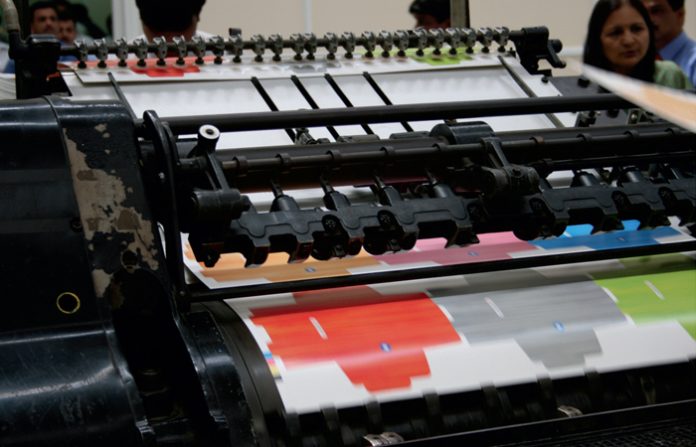
Last year’s decision to change the drupa cycle from four to three years may be considered a sign of optimism, but it may just as well be one of necessity. Both four- and threeyear cycles have drupa and interpack coincide at some point, so whether this requires shuffling with dates or not, purely depends on cost-benefit assessments undertaken by Messe Düsseldorf and its exhibiting partners.
In the first fifty years of its existence, drupa frequencies were rapidly moving from three and four to five year intervals, until the year 2000, when the four-year cycle was reintroduced. For the past ten years, most of the world has been dragging from one economic crisis to the other, and major machine builders and software developers are under increasing pressure to respond to market demands or create new ones. For them, trade shows still play an important role in marketing their products in time and orienting customers in their search for technology-driven business opportunities.
This drupa is supposed to be the third ‘inkjet-drupa’ and the fifth overwhelmingly determined by digital technology. 1990 and 1995 already saw a panoply of digital innovations, particularly in the areas of data exchange and CtP, but the real breakthrough came a little later. The internet bubble had already burst when the hype around eCommerce infected drupa 2000, but attentive visitors could also spot the first mature digital presses and significant networking technologies at this show.
drupa 2004 was characterized by workflow and press automation, jdf, lower-cost technologies such as small format CtP, processless plates and digital proofing, and high-speed mono inkjet. In 2008, just before the heavy metal press builders started to realize the crumbling of their markets, drupa was the platform where inkjet showed its potential as the mature technology it has become in terms of print quality, speed and cost.
While attempts were made to hype ‘hybrid’ and ‘nano’ at drupa 2012, Frank Romano hit the nail on the head by terming it ‘the inkjet drupa on steroids,’ because by that time it was clear that inkjet was about to make serious inroads in all printing applications, sheetfed and webfed, commercial, publishing, object, industrial and packaging printing. Even 3D printing is based on inkjet principles. drupa 2016 will see further developments in heavy duty high quality and high volume inkjet presses in each of these segments.
For visitors, drupa is still one of the main occasions to verify whether their intended short- or longer-term investments are in sync with technology developments and markets trends. Many of them may be charmed by the latest nano- and 3D-presses on show, but we can safely assume that most interest will go to equipment extending existing commercial and packaging printing operations with complementing, not replacing, technologies. This is particularly true for pre- and postpress, and in presses that can reliably handle different substrates.
In the current economic situation, in which growth rates for print are under pressure even in emerging economies, printers are less keen to invest in anything else than what ensures them income right from day one. They would also invest in the security of their IT networks, but, as things are, software supplier priorities seem to be more focussed on ever shorter time-to-market cycles for their upgrades than on serious IT security developments in a world of internet viruses and database hackers, and, unfortunately, drupa 2016 will not make a difference in this regard. Another area of interest across all printing segments is print quality standardization. ISO’s technical committee in charge of print standards, TC 130, will actually use drupa to hold Working Group meetings in Berlin and Frankfurt on the days before and after the show. Main issues to be discussed include an ISO 12647-7 (proofing from digital data) update and further elaboration of the disputed standard ISO/TS 15311 for digital printing.
Global competition
The printers and packaging converters I have been working with in several countries over the past few years, have gone through multiple cost-cutting, standardization and automation cycles, and are now looking at ways of adding services and products for market segments with lower competition levels. At present, they appear to be less concerned with their domestic competitors and more with the competition from ‘abroad.’
Last year, the world’s printing industries achieved an estimated sales volume of US$ 760 billion, of which, roughly, US$ 230 billion was commercial printing, US$ 230 billion was packaging printing, US$ 180 billion was publications printing including books, and US$ 120 billion was in the other print segments. Numbers on global industry demographics are not very reliable, because the available statistics, even those that are detailed and up-to-date, are full of tricky overlaps, opaque classifications and differently interpreted categories, which leaves most comparisons questionable. A fact is, however, that print markets’ trade patterns have drastically changed over the past twenty years.
As an example, the German printing industry achieves 14 to 15% of its sales turnover in exports, mainly to its neighbours within the European Union. This percentage has hardly changed over the past twenty years. In contrast, German imports of print have not only tripled over the same period, but have shifted from Western Europe (UK, Italy, Netherlands) to Eastern Europe (Poland and former Yugoslavia), China, Turkey and the Middle East. In 1995, the US was still a major exporter of print (to Canada, Australia, Europe and Mexico mainly). Since then, US print exports increased by a mere 5%, while US print imports increased by 60%. Chinese print exports to Europe alone increased from US$ 94 million in 1995 to US$ 980 million in 2015.
At the same time, the printing industries of Western Europe and North America contracted considerably. Between 2000 and 2015, printing in the 28 countries of the European Union shrank from 134,000 enterprises, with 850,000 employees and a sales turnover of US$ 228 billion, to 118,000 enterprises (-12%) with 680,000 employees (-20%) and a sales turnover of US$ 218 billion (- 4%).
In the US, the number of commercial printers alone fell from 45,000 in 1990 to 26,000 (-43%) in 2015, their employee base from 816,000 to 446,000 (-46%) and revenue from US$ 124 billion to US$ 87 billion (-30%). Total printing industry revenue decreased by 12%. At the same time, consolidation led to 40- 50% increases in the average revenue per employee, without significantly improving profitability. (Sources: Intergraf, VDMA, bvdm, Primir, US Department of Labor, US Census Bureau.)
Patterns are very different between commercial, publication, signage, object, industrial and packaging printing, but a fact is that competition is increasingly globalizing, and that both relocation or outsourcing over long distances and close-to-market business models are functioning in each of these areas. For customers, all that matters is to which extent each of these fit into their supply chains. In this picture, some regions with high growth rates are generally underestimated due to their low starting base. Thus, North American companies are increasingly sourcing their printing needs in Latin America and from printing companies not seldom owned by North American corporations.
In Western Europe, but also in North America, packaging printers and converters in Turkey, the Middle East, Ukraine and Russia are gaining ground, while publishers of books and magazines increasingly turn to printers in Eastern Europe, former Soviet republics and, particularly for school books, the Middle East. In a recent presentation, Heidelberg observed, over the past few years, compound annual growth rates in overall print volumes of 5.4% for Eastern Europe, 5.1% for the Middle East and 4.1% for Latin America, against 2.9% for Asia, 1.8% for Western Europe, and 0.4% for North America. The numbers may not always add up in detail, but they do reflect actual proportions and overall trends for the years to come.
Benchmarks
International competition being the number one concern for commercial and packaging printers alike, companies are paying particular attention to benchmarks, to which they try to tune their key performance indicators. Overall industry benchmarks, although helpful, have to be considered with a pinch of salt, however, because they are based on statistics which mostly are not segment-specific or transparent in terms of overlaps, omissions and interpretations.
For instance, numbers on employee productivity largely depend on the calculation of the number of enterprises and total workforce in a particular region. Based on these suppositions, average revenue per employee across all print segments is estimated at US$ 200-220,000 for North America; US$ 140-220,000 for Western Europe; US$ 40-80,000 for Eastern Europe; US$ 40-50,000 for Turkey; US$ 20-40,000 for China; USD 15-30,000 for India; and, US$ 10- 30,000 for the Middle East.
Some of the top commercial and packaging printers in Eastern Europe, Russia and the Middle East can be found in the range of US$ 10-20 million sales turnover with 200 to 300 employees and revenue per employee between US$ 30,000 and 60,000. Some base line comparisons from the following printing industries offer some benchmarking perspective (2012 numbers): Germany 12,000 companies, 190,000 employed, revenue US$ 42 billion, per employee 221,000; UK 18,000 companies, 190,000 employed, revenue US$ 40 billion, per employee 210,000; Netherlands 2,900 companies, 44,000 employed, revenue US$ 9.5 billion, per employee 216,000; Belgium 1,600 companies, 18,000 employed, revenue US$ 4.5 billion, per employee 250,000; USA 42,000 companies, 840,000 employed, revenue US$ 175 billion, per employee 209,000. In Germany, less than 3% of the 12,000 companies have more than 100 employees. The category of companies with revenues of more than US$ 10 million employs between 50 and 100 people and on average achieves a revenue per employee of around US$ 160,000.
More useful are segment-specific benchmarks at individual enterprise level. Unlike balance sheet ratios, which to some extent can be found in companies’ annual reports, operational benchmarks from comparable and profitable competitors may be hard to come by. Some professional federations encourage members to provide and share these data, but mostly the results of these surveys are doubtful. According to Heidelberg, the average cost structure of sheetfed offset printers with more than 20 employees in Germany presented itself a few years ago as follows in percentage of sales turnover: direct cost of sales 45%, salaries 31%, finance 10%, running costs (overhead) 11.6%, profits before taxes 2.4%.
The German printers federation bvdm calculated that, on average, materials, purchase and outsourcing represent 48% of costs, payroll 30%, finance 10% and overheads 12% of total costs. Next to operational benchmarks for makeready times and the like, the most important indicator with which a printer will be measuring the company’s performance remains the cost of goods sold (COGS) and its proportional composition. Just as an example, a reasonably profitable commercial printing company, with a typical portfolio of advertising materials, catalogs, magazines, books and folding carton packaging, would have an overall COGS of 75%, roughly composed of paper 40%, plates 4%, ink 3%, other consumables and spareparts 6%, wages 12% and overheads 10% of total sales turnover.
Key performance indicators for printers
More important than chasing international benchmarks and statistics, however, is the regular monitoring and finetuning of printers’ own performance indicators. Key performance indicators, or KPIs, are the quantifiable measurements reflecting the critical success factors of the business.
KPIs enable senior management to monitor the strategic direction of the business, identify hot spots that need attention and act rapidly in order to drive the business forward. They underpin the larger business objectives, hence refer to strategic decisions such as markets to be served, customer profiles, critical internal processes required to capture and satisfy customers, as well as the individual and organizational capabilities required.
KPIs reflect critical success factors from four strategic and interlinked perspectives:
- Financial Perspective – e.g., return on capital, revenue, profit, cash flow;
- Customer Perspective – e.g., market share, customer satisfaction, customer retention;
- Internal Business Processes – e.g., costs, timeliness, quality, returns, rework;
- Innovation and Learning Perspective – e.g., vision, product mix, skills, staff retention.
KPIs enable the assessment of how performance in different processes affect each other. They measure the drivers identified as being critical to achieving particular goals. These need to be prioritized, consistent, and mutually reinforcing. The profitability of the business depends on how well staff consistently performs critical activities, which in turn depends on their understanding of their performance’s impact on the bottom line. In practical terms, KPIs can be divided into those that are directly related to the overall business objectives, to be circulated as simple reports on a fortnightly or monthly basis, and those consisting of realtime reports on departmental performance, that is, mainly actuals versus targets, whereby the targets are to be reviewed on the basis of experience.
Both could be discussed at regular intervals, but instead of having every manager read out their detailed reports on past performance, useful KPI presentations are based on summaries in which primarily the goals and corrective action are discussed. As far as departmental performance measures are used for staff performance evaluation, a weighing of the different indicators may be appropriate, in order to distinguish strategic and business critical ones from the more basic operational targets. In the end, it is the strength of the internal organization which will decide how a particular printing company withstands and outperforms the competition.

















